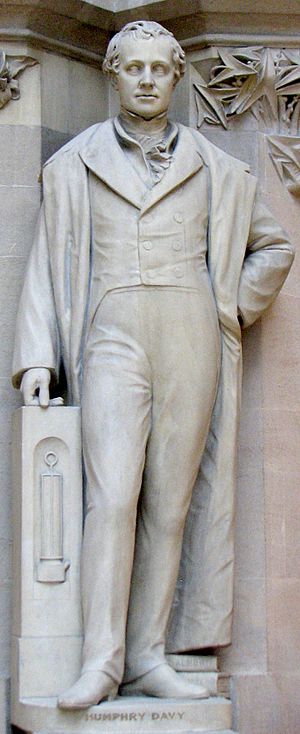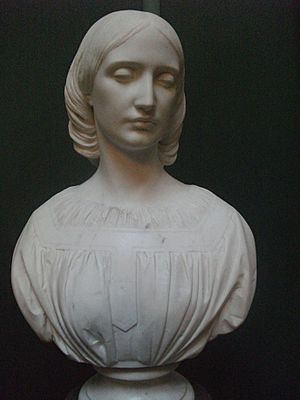Alexander Munro (sculptor) facts for kids
Quick facts for kids
Alexander Munro
|
|
|---|---|
| Born | 26 October 1825 Sutherland, Scotland
|
| Died | 1 January 1871 (aged 45) |
| Nationality | British |
| Occupation | sculptor |

Alexander Munro (born October 26, 1825 – died January 1, 1871) was a talented British sculptor. He was part of a special art group called the Pre-Raphaelite movement. Munro was famous for making sculptures of people and statues. His most well-known work is a sculpture called Paolo and Francesca. Many people think this sculpture perfectly shows what Pre-Raphaelite art was all about.
Contents
Life of a Sculptor
Alexander Munro was born in Sutherland, Scotland. His father was a stonemason, which means he worked with stone. Alexander's talent was noticed early. The Duchess of Sutherland, who was his father's boss, helped him financially.
Early Training and Moving to London
In 1842, Alexander started training with another sculptor, Alexander Handyside Ritchie, in Edinburgh. Later, in 1848, he moved to London. There, he studied sculpture and also worked as a mason on the new Palace of Westminster. This is where the British Parliament meets.
From 1849 to 1870, Munro showed his artwork at the Royal Academy. He also displayed his sculptures at the Great Exhibition of 1851. This was a huge event that showed off new inventions and art from around the world.
Working with Famous Artists
Munro became good friends with Thomas Woolner. Woolner was the only sculptor who was part of the original Pre-Raphaelite Brotherhood. This was a secret group of young artists who wanted to change art. Munro was also close with Dante Gabriel Rossetti, another famous Pre-Raphaelite artist.
Munro played a small part in a big discussion about the Pre-Raphaelites in 1850. He shared the information that the group was a secret brotherhood. In 1854, Munro started teaching at the new Working Men's College. He taught alongside other famous artists like Dante Gabriel Rossetti, Ford Madox Brown, Edward Burne-Jones, and John Ruskin.
Munro's Famous Sculptures
Munro's sculptures were known for being simple and clear. His most famous work, Paolo and Francesca, was shown at the 1851 exhibition. This sculpture showed two lovers looking calm and dreamy. It helped create the popular image of the Pre-Raphaelite art style. The final marble version of this sculpture is now in the Birmingham Museum and Art Gallery. An earlier plaster version is at Wallington Hall.
Munro also created public sculptures for places like Berkeley Square and Hyde Park Corner in London. He made several statues to remember important people. For example, six of the seventeen statues of scientists at the Oxford University Museum of Natural History were made by him around 1860.
Later Life and Family
Alexander Munro was not always healthy. He suffered from a lung disease that made him weaker over time. In his last years, he and his wife lived in Cannes, France, for his health. He passed away there on New Year's Day in 1871.
Munro married one of the daughters of a journalist named Robert Carruthers. They had two sons. The famous art critic John Ruskin was the godfather to one of their sons. His son, John Arthur Ruskin Munro, later became the head of Lincoln College, Oxford.
Key Works by Alexander Munro

Alexander Munro created many sculptures throughout his career. Here are some of his notable works:
- Busts and Medallions: He made many busts (sculptures of a person's head and shoulders) and medallions (round or oval sculptures). These included busts of Mrs. Banks (1849), Sir Robert Peel (1854), William Gladstone (1855), and Josephine Butler. He also made medallions of famous artists like John Everett Millais (1854).
- Children's Sculptures: Munro was known for creating beautiful portrait busts and groups of children for wealthy families. Examples include The Ingram Children (1853) and The Gladstone Children (1856).
- Public Statues: He created large statues for public spaces. These include a statue of Herbert Ingram in Boston, Lincolnshire (1862) and a statue of Mary II of England for the Houses of Parliament (1863).
- Scientists at Oxford: For the Oxford Museum, he sculpted statues of important scientists like James Watt, Gottfried Wilhelm Leibniz, Hippocrates, Sir Isaac Newton, Galileo, and Sir Humphry Davy (1863).
- Fountains and Park Sculptures: He designed a fountain in Berkeley Square (1865) and the famous Boy and Dolphin statue for Hyde Park (1865).
Images for kids
-
Bust of Josephine Butler





